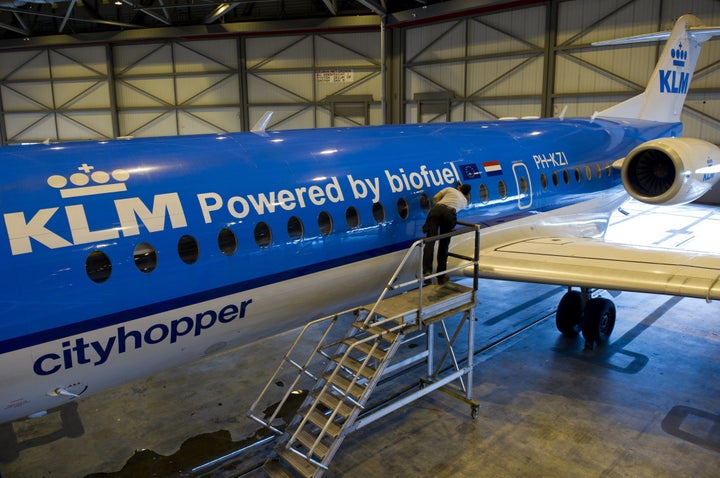
Aviation is responsible for an estimated 2 percent of human-generated carbon dioxide emissions. The industry's rapid growth is doing nothing to decrease that figure, but airlines are nonetheless working to scale back their emissions. One tactic that’s been gaining traction: biofuels.
In June, KLM announced that it would begin operating more than 200 flights using biofuel in September. In July, Lufthansa, Finnair and Thomson Airways launched their bio-fueled flights. And in August, Aeromexico flew what it called the first biofuel-powered transcontinental commercial flight.
Among major U.S. carriers, those that have made varying commitments to biofuels include US Airways, United (and a pre-merger Continental), Delta and American Airlines.
“A key pillar of the environmental commitment of the combined company is a commitment to alternative fuels,” said Jimmy Samartzis, managing director for global environmental affairs and sustainability at United.
“We have entered into multiple agreements to purchase alternative fuel for use in aircraft and ground equipment," a spokesperson for US Airways told HuffPost Travel in an email. "These agreements involve the combined purchase of approximately 75 million gallons per year of jet fuel and diesel fuel derived from camelina oils or comparable feedstock.”
Fuels Of The Future
Biofuels are alternative fuels that originates from living organisms -- mostly plants and algae. They can also be derived from recycled cooking oil.
Plants that can potentially serve as biofuel sources for airlines include camelina, jatropha, agave, castor and algae -- crops that are especially useful given their ability to grow on marginal or degraded land.
“Camelina [for instance] doesn’t require the rich soil that corn and soybeans do,” said Jan Jaworski, researcher and principal investigator at the Donald Danforth Plant Science Center in St. Louis, Missouri. “So you can begin using land that is now currently used for other things or not used at all.”
Lisa Mortenson, CEO of Community Fuels, points out that camelina plants can be rotated with others like wheat, growing at a time when fields would otherwise be bare. This method would not only utilize empty land, but it could help to protect the soil and even improve its nutrient content.
Another potential biofuel source, algae, can help to reduce atmospheric carbon. Carbon dioxide can be captured from places like coal power plants and injected into algal ponds as fertilizer, according to Richard Sayre, director of the Enterprise Rent-A-Car Institute for Renewable Fuels at the Danforth Center. These ponds can also recycle wastewater from municipal treatment facilities and feedlots, and they can be placed on marginalized land.
Given that biofuels are likely to be consumed near where they’re produced, they offer potential additional benefits: emissions released during transportation will be reduced, as will transit time. Therefore, while biofuels and petroleum-based fuels have virtually the same shelf life, biofuels won’t lose as much life in transit, Mortenson pointed out. Biofuels are also unlikely to be stored underground or on a tanker in the same quantities as petroleum-based fuels, Jaworski said, which lessens the associated danger of spilling.
Using biofuels could have economic benefits as well as environmental ones. “I think there’s a tremendous opportunity to develop a domestic, sustainable energy policy that will reduce the dependence on foreign oil,” said Sayre. “If we made that oil in the United States, not only would we keep that money in the country, we could create jobs.”
Not So Fast
But biofuels aren’t without their challengers. Timothy Searchinger, research scholar and lecturer at Princeton University, points out an important nuance to the carbon-reduction argument. “Land grows plants whether you use them for biofuels or not,” he said. “So, those plants were already absorbing carbon from the atmosphere. The only way you would get a [CO2] reduction when using biofuels from plant growth is if you grow additional plants.”
Others argue that rainforests (and other lands) are being slashed to make way for biofuel crops, and that food crops are being diverted from peoples' mouths to engines.
Some airlines have already moved to address these concerns. Lufthansa posted the following announcement on its website: “In the procurement of biofuel, Lufthansa ensures that it originates from a sustainable supply and production process. Lufthansa guarantees that the production of its biofuel is not in direct competition with food production and that no rainforests are destroyed.” The company says it will require suppliers to provide proof it is using sustainable production methods and meet the criteria outlined by the European Parliament and the Council in the Renewable Energy Directive.
Jaworski believes that the food vs. fuel question is only an issue today because ethanol is currently derived from corn, which he believes will change in the future. “In the next five to 15 years this argument will no longer be a point of discussion."
A Good Investment
While jet fuel is currently the biggest cost for airlines, some believe that using biofuels will help stabilize fuel prices and supply.
“We face a lot of volatility with fuel pricing because of crude oil volatility," said Samartzis, of United. “We look at this as a potential way to manage that to some degree.”
Yet like any new technology, biofuels will initially be expensive, raising questions about whether that cost will be passed to the consumer.
“We don’t expect that we will have to face that challenge," said Samartzis. "As far as we can tell … we can get the cost to be competitive with conventional jet fuel.”
Cost issues aside, biofuels have the highest energy density of all fuels currently available. Airlines looking to become more efficient are taking notice.
“We as a company and [an] industry have made a commitment to achieving certain fuel efficiency improvements and carbon reduction goals long term," Samartzis said. "In order to achieve those on a collective industry basis, alternative fuels are a key component.”